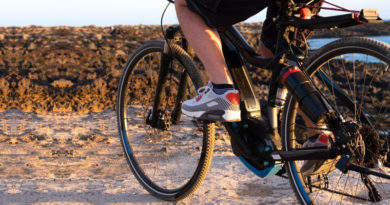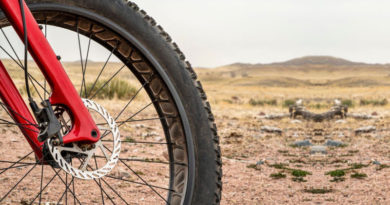Can you put Wider Tires on your Bike?
Recent trends in cycling have seen professional athletes shifting to wider tires. This shift has started a wave among cyclists of all skill levels. If you are one of them, you would probably be asking the same question. In fact, you are encouraged to put wider tires on your bike. Data suggests that wider tires are better performers than thinner tires contrary to popular belief. However, it depends on your bike frame and fork clearance, as well as the brake calipers. Make sure the wider tires are compatible with your bike and that there is enough clearance for them to fit properly.
This article explains how putting wider tires on your bike can benefit you.
Why should you put wider tires on your bike?
Newly emerged data has shown that wider tires have certain advantages over their narrower counterparts. Here are a few reasons why you should go for wider tires:
Comfort
Thinner tires are less comfortable. Thinner tires have to be pumped to the limit to prevent them from becoming flat under load. The more pumped the tire, the harder it is. Hard tires transfer every bump on the road to the frame. As a result, the rider becomes fatigued quickly.
Thicker tires, on the hand, can be run with lower pressure absorbing more bumps coming from the surface. A lower pressure with more air volume results in a smoother ride. The comfort factor is driving even professional riders to adopt wider tires for their bikes.
Rolling Resistance
It is a common notion that a wider tire would have more contact area with the surface. This increased contact area would amount to more rolling resistance as it causes more friction. It turns out, that the data was for the highest air pressure in the tire. But when you start playing around with the air pressure and volume inside the tire, things change.
Recent studies have found that lower pressure and more air volume in the tire cause less rolling resistance. That is because, with an equal amount of air pressure, a thinner tire would flatten more than a wider tire under load. The increased contact area of a thinner tire would produce more rolling resistance in the long run.
Handling
Wider tires provide a better grip. One reason is obviously that they have more contact area than a thinner tire. The other reason is that a tire with low pressure would better morph itself to the protrusions and depressions of the surface during cornering. Mountain bikers have known these tricks for ages.
Better Cornering
When we get into the corners with wider tires, we feel that the bike feels more planted in the corners and less affected by patches of rough tarmac mid-corner that could throw you off your line. This is one of the benefits of the bigger contact patch and the tire’s ability to float over damaged road surfaces. You do need to be cautious with the tire pressures, though; if they are too low, the tire may wiggle beneath you, which is not what you want because it will slow you down and make you feel quite shaky when cornering.
Limiting Factors
The frame of your bike is a greater limiting factor than the rim. A wider tire causes clearance issues. It’s usually the front fork arches and blades and chainstays and brake bridges in the rear. Brakes are another limiting factor. The type of brakes on your bikes would determine the maximum width of your tire.
The only other thing you have to worry about is the diameter of your rim and the bead seat diameter. They have to be the same for the tire to fit onto the rim. In theory, you can fit a tire as wide as you want as long as the bead seat sits perfectly inside the rim.
What if the tire is too narrow or too wide?
As with all things, there has to be a balance to get maximum performance or output. Disregard that balance and you will have problems. The advantages mentioned above only work to a certain degree. If you get a tire too wide or too narrow, you lose those advantages. Here is what happens when the tire is too narrow or too wide:
Too Narrow
A tire too narrow becomes squared under load. The increased contact area generates more rolling resistance. The sidewalls become overexposed because they are stretched out. In such cases, the sidewalls are more susceptible to cuts and punctures. A square tire would also provide less grip during cornering and also loses its dampening characteristics. Without dampening, the rim also becomes more susceptible to damage.
Too Wide
A tire too wide would become too tall and round if it fits the rim in the first place. The shape of the tire would be reminiscent of a light bulb in such a case. The tire would become floppy at the top resulting in poor cornering performance and tire squirming.
So don’t go too wide
Going too wide can have a negative impact on speed. Various types of research from the likes of specialized Schwalbe and others suggest that the sweet spot for speed sits between 25 and 28 millimeters. How wide you end up going depends on the riding that you’ll be doing. If you’re a racer and you’re looking to go as fast as possible well we wouldn’t recommend going above say 26 or 27 millimeters. However, for those of you that like just getting out in the lanes on your bike, well, you can go as wide as you want.
How to choose the right width for your bike?
As a rough guide, here are a few categories of bikes and the lengths they can accommodate:
- Mountain/Adventure bikes (30-50mm): These bikes are popular because of the wide variety of tire widths you can fit on these bikes. These bikes can handle a variety of conditions and wider tires help with rough terrains. But the tire width depends on the riding conditions you would most likely be facing. Narrow tires for more paved conditions and wider tires for more gravel and mud.
- Touring and commuting bikes (25-45mm): Most versatile. They come in many shapes and sizes depending on usage ranging from fast and light to heavy-duty models. Comfort is preferred in these bikes over speed and acceleration. Therefore, these bikes come fitted with wider tires than regular bikes of a particular category. Usually 25mm for road category and up to 45mm for off-road rides.
- Endurance bikes (25-32mm): Usually based on race bikes but built for relatively more comfort than you would find in race bikes. 28mm is common in endurance bikes for the best comfort and performance. But some endurance bikes can accommodate wider tires.
- Race bikes (23-25mm): Race bikes have the narrowest tires. Narrow tires reduce weight and improve aerodynamics. For years, 23mm has been the standard in race bikes. But 25mm is slowly becoming the default choice. Some race bikes can even accommodate tires up to 28mm wide.
If you want to know the right width of the tire for your bike, the best source is the information provided by the manufacturer. However, you can find other guides online as well to see how wide of a tire you can fit on a particular size rim. These guides often also mention the categories of bikes for optimum performance.
Conclusion
Professional athletes are shifting to wider tires on their bikes. Following the trend, cyclists of all levels have started putting on wider tires on their bikes. Recent data suggests that wider tires are indeed better performers than thinner tires. They provide more comfort, less rolling resistance, and better handling.
The bike frame and rim size are major limiting factors on how wide a tire you can put on your bike. Increasing the width of the tire within a certain limit will increase the performance of your bike. Beyond that, the performance would suffer. To find the optimum tire width for your bike, check the details provided by the manufacturer for your particular model. You can also look for other guides on the internet for the best tire width.




